theSpecialist
In this issue:
A fisher’s tale: Where have all the salmon gone?
A jewel in the crown: The Black Prince’s Ruby


theSpecialist
In this issue:
A fisher’s tale: Where have all the salmon gone?
A jewel in the crown: The Black Prince’s Ruby

We hope you will enjoy the diverse range of articles, some of which are associated with the sort of assets we insure; from houses and estates through to racehorses and jewellery, though not quite the crown jewels yet!
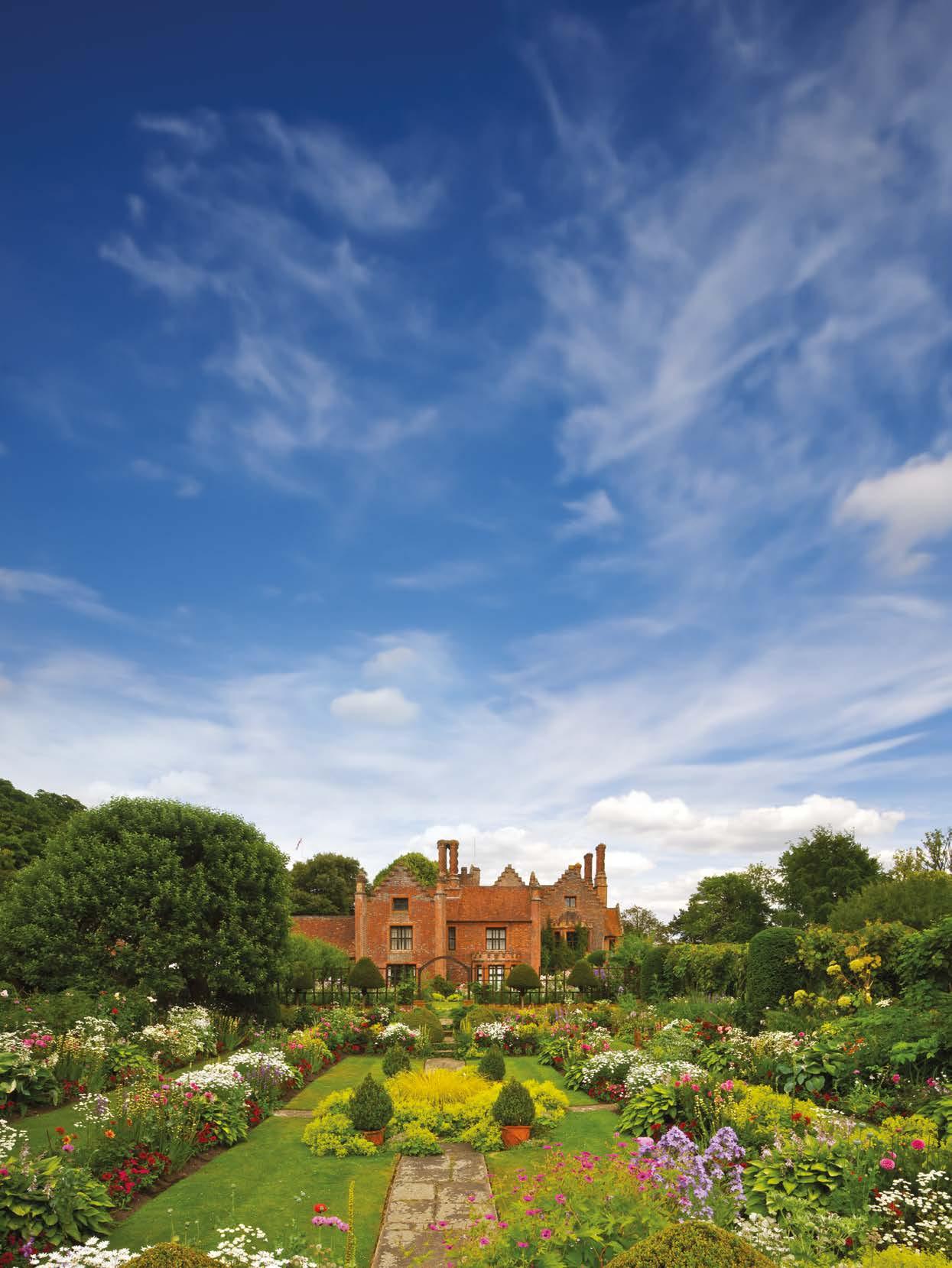
In January this year we celebrated our 10th anniversary and by continuing to offer an exceptional quality of advice and service, coupled with a determination to obtain the best results for our clients, we have every reason to be optimistic about the next ten. Operating from seven locations across the country, we are extremely well placed to visit our clients wherever and whenever they want and help them as much as we can.
Please do not hesitate to get in touch with either of us if we can be of assistance in any way.
Alec Moore JOINT CHIEF EXECUTIVE
 Richard Chugg
JOINT CHIEF EXECUTIVE
Richard Chugg
JOINT CHIEF EXECUTIVE
Higher temperatures increase the amount of moisture the atmosphere can absorb, which in turn translates into more storms and heavier rains when the heavens do open. Paradoxically there are more dry spells as water evaporates from the land, but very heavy rain is now more frequent and devastating events such as Storm Desmond are statistically 59% more likely to occur than 30 years ago.
This has resulted in many homes being flagged up by insurers as at risk of flood, including large swathes of London following torrential downpours there in the last couple of years, whereas previously they may have been viewed as zero or very low risk. In the urban environment it is normally the risk of run-off from hard surfaces that is the issue, rather than the proximity of a watercourse.
In 2016 the insurance industry launched the Flood Re scheme to keep the cost of flood insurance both available and affordable for households located in significant risk areas. The scheme is run on a not-forprofit basis and is financed by a levy from all subscribing insurers. The Government does not subsidise the scheme but instead provides resources to fund relief if the country is hit by an especially costly flood.
Flood Re is effective across the UK and in 2022 covered 256,634 homes. To avoid incentivising the building of houses on land with a high flood risk, the scheme excludes houses that were built after 2009
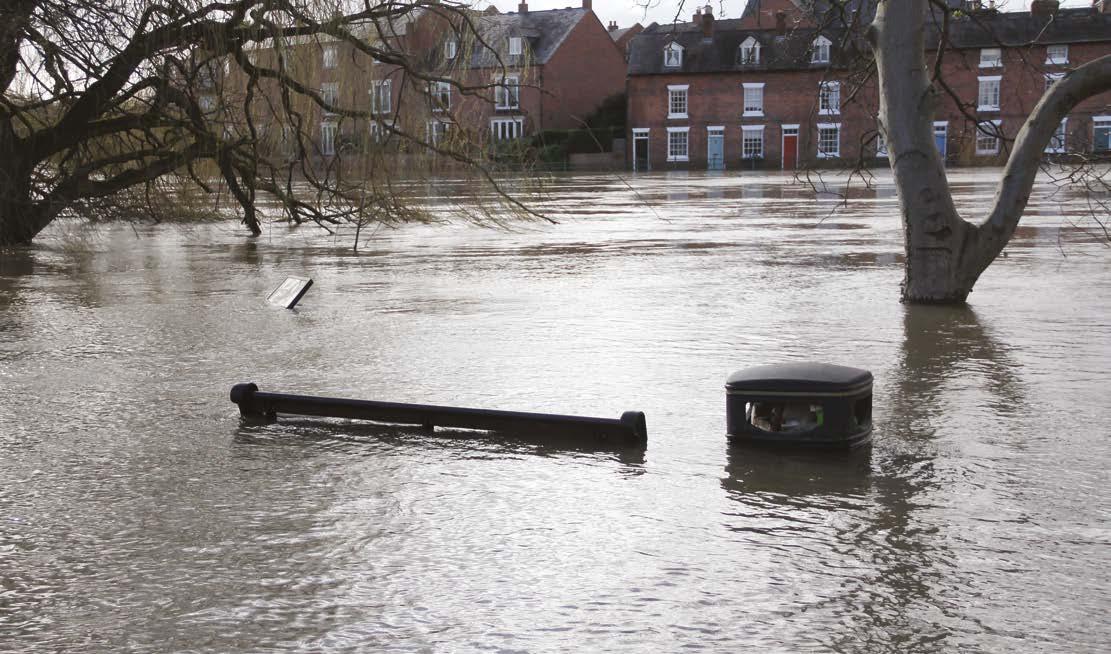
when a separate agreement between insurers and Government concerning flood risk came in to being.
When an insurer cedes the flood element of a risk to Flood Re this obviously does add to the cost of insurance but crucially ensures that a house can be covered for flood damage. When going through the process of purchasing a house it is most important to take heed of the results of the environmental searches. If these flag a risk of flood, as long as the house will be your home ie it will not be let and it was built before 1st January 2009, you should be able to insure the property against flood damage and comply with the conditions of most mortgages.
When it was established in 2016 Flood Re was expected to be in place for 25 years, to allow time for improved flood mitigation investment to have an effect and to enable the insurance market to return to regarding flood as an unexceptional risk. Time will tell whether this can be achieved but the jury has to be out as to whether Flood Re will need to exist for longer than originally envisaged and it would be brave to bet against it.
As global temperatures increase, extreme weather events become more likely and more severe.
Statistics, as we all know, can be used to prove anything, but when they all point in one direction even Donald Trump would be pushed to put a contrary spin on them.
So let’s start by depressing ourselves as to how bad things are with that most remarkable of all fishy visitors to our rivers and shores, the Atlantic salmon. Of course, because they live underwater, both fresh and salt, nobody knows for sure how many there have been in the past and there are now, but here are just some of the stats that few would disagree with.
There has been an 85% decline in salmon numbers returning to UK rivers since the 1960s and this is despite almost all offshore, high seas and in-river commercial netting having been stopped. Catches from all these nettings in the 1960s would routinely exceed 100,000 salmon, sometimes as high as 500,000, and that is with netting operators seldom being completely honest about what they caught. In other words, the real catches were much higher and yet the numbers of salmon in all our rivers are now at all-time lows.
Also, prior to the 1980s, not only was there massive netting, but anglers killed nearly every salmon they caught, whilst now 95% + are returned unharmed to the river.
The reality is stark. That greatest of all Welsh rivers, the Wye, which routinely had catches by rod and line of over 6,000 salmon every year, is now more likely to see around 200-500. Pre 2014, the Tweed’s average rod catch was 16,000 salmon and now it is around 6,500.
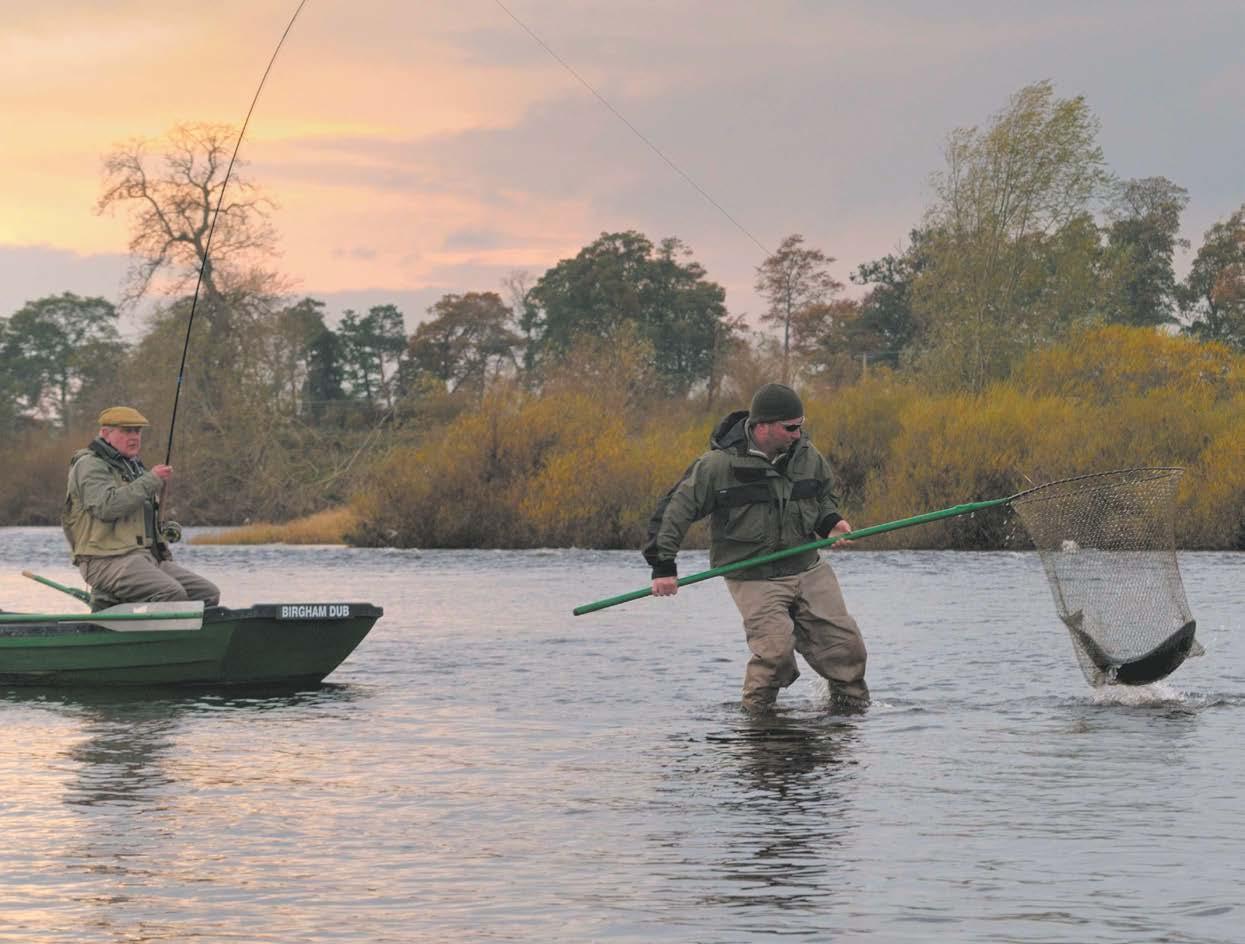
The fabled autumn runs of big salmon on the Tay, Tweed, North Esk and other rivers have all but disappeared, and having been the strongest component of runs on many rivers for 40 years, the autumn run has now all but vanished, so that fresh silver salmon coming into rivers after midAugust are virtually non-existent. Alarmingly, this transition from abundance to a complete dearth has happened almost overnight.
The great puzzle is why? There are well meaning and hugely able, committed pro-salmon bodies and individuals all around the UK who have been working hard for decades now, trying to solve it and reverse the seemingly inevitable downward trend. To say they have been unsuccessful would be both unkind and untrue, for it would have been a lot worse without them. But still the decline has continued, albeit maybe at a slower pace now than before, and we have yet to see any sign of an upturn, let alone the Holy Grail, a sustained upturn.
Pundits and salmon experts can produce a list as long as your arm of the likely culprits. From salmon farms, predators (both avian and other), water quality (the Wye again) and water quantity, to degraded in-river habitat for young fish, global warming both at sea and in rivers, and more extremes of drought and flood; all of which are harmful to the in-river survival of juvenile, and to a lesser extent, adult salmon. I could go on.

When I were but a lad in the 1960s, scientists would tell you that up to 30% of the smolts (young migrating salmon) starting their journey out to sea would return one, two or three years later as adult salmon. Now some say that is less than 3%.

And the answer to the puzzle could be as simple as that; survival, for reasons largely unknown, has become distinctly marginal for our young salmon once they reach the sea. Yes, there are 160,000 salmon eating seals around the coast of Scotland now, when in the 1960s there were a fraction of that. Yes, there are now inland cormorants in the winter and goosanders or mergansers on our rivers all year round, whose numbers can only be reduced under licence. Of course none of that helps. But it is hard to imagine that increased predation is more than a small contributory factor to the decline, when only 13 years ago the Tweed had its record ever catch by rod and line, and yet both seals and avian predators abounded then too.
So if sea survival is the missing link and the cause of the decline that we are all looking for, is there anything we can do in the sea to stop it? If sea warming and consequent changes in ocean currents and salmon’s prey species (what they eat), as well as a proliferation of competitors for the same food, are the cause, how can we possibly alter that? As global warming may be the root cause of all that is making life precarious for our young salmon in the sea, if sea surface temperatures are not going to decline, and indeed may well increase in the medium term, is there anything we can do to improve sea survivability?
The short answer may well be “No”. It is for that reason that river managers increasingly concentrate on improving in-river conditions (water, habitat, shade, temperature etc) in order to maximise smolt production, so that, in the simplest possible terms, if we can send 1 million smolts to sea by increasing in-river production, as opposed to 500,000 previously, we may be able to double the number of returning adults, if still only at a rate of 3%.
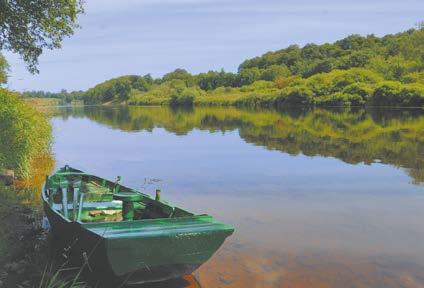
The great worry for us all is that the salmon is a cold water loving fish, and that in an ever warming world its survivable range will go, indeed has already gone, ever further north. There used to be salmon in abundance in the rivers of Northern Spain, on the west coast of France and all around the North Sea’s eastern rim. Not just for warming reasons admittedly, there are now very few, if any, in their rivers. 90%+ of current salmon populations are in Scotland, Ireland, Norway, Iceland and Russia, and it is brave to argue that this process will not continue, the retreat ever northwards. There is evidence, from catch numbers alone, that the further south rivers are in England and Wales, the more they are struggling to produce runs of salmon, and certainly nothing like what they were 50 years ago. In 2021, the Tweed, with one of its lowest catches ever, caught more salmon than all the 70+ salmon rivers in England and Wales added together; concerning for the Tweed, but even more so for all its more southerly colleagues.
Sir David Attenborough in his recent Wild Isles programme said that the Atlantic salmon in the UK may be extinct within the next 20 years. I do not buy that, but what seems certain is that we will have to fight its corner, every inch of the way from now on, to avoid it.
Or else, he could be right.
Eagle-eyed viewers of the coronation may have noticed a change in headdress when the King moved from Westminster Abbey to Buckingham Palace.
Crowned in the gold of St Edward’s Crown the King appeared on the balcony having replaced it with the even more dazzling Imperial State Crown, embedded with no fewer than 2868 diamonds, 17 sapphires, 11 emeralds and 269 pearls. Amongst this shimmering array are several notable jewels including the Cullinan II, sometimes referred to as the Second Star of Africa, which sits on the front of the crown. Cut from the largest diamond ever to be found, its even larger sibling, the Great Star of Africa, adorns the top of the Sovereign’s Sceptre. At the back of the crown, encased in gold, is the beautiful cornflower blue of the Stuart Sapphire but for the most interesting of the great jewels of state, a return to the front is required. Sitting above the Cullinan II and mounted on a diamond encrusted Maltese cross, is the Black Prince’s Ruby.

The first thing to note about this stone is that it is not actually a ruby at all but a cabochon red spinel. Weighing an extraordinary 170 carats, this beautifully smooth gem is remarkable for its colour, irregular shape and the long tale behind it. The stone is thought to have been mined in Badakhshan,
a tribal territory that now covers northeast Afghanistan, eastern Tajikistan and a fragment of western China. The stone belonged
As Arab rule collapsed, Abu Sa’id looked to surrender to the ominously named Don Pedro The Cruel of Castille. Don Pedro asked the prince to appear in Seville to formally surrender, only to have Abu Sa'id murdered along with his retinue, the ruby being found when his body was stripped. In 1366 a revolt broke out, threatening to overwhelm the state and in his desperation, Don Pedro looked for
Enter the Black Prince, Edward of Woodstock, The Prince of Wales, the eldest son of Edward III. His career had taken off when he successfully commanded the right wing at the Battle of Crecy in 1346. At only sixteen years old, the flower of the French nobility was launched at his position, his military adviser’s requests for aid being dismissed by the onlooking Edward III, telling them instead to “let him win his spurs”. The prince did this in spectacular fashion killing John, the King of Bohemia, and in the process fast becoming one of the most feted commanders in Christendom over the following years. Asked by Don Pedro to assist in suppressing the rebellion, the Black Prince exacted the ruby as part of his price.
Following Crecy and having killed the King of Bohemia, the Black Prince took the crest of his vanquished opponent – the three ostrich feathers and inscription of ‘Ich dien’, or ‘I serve’, that still makes up the crest of the prince and principality of Wales. Any observer of the ruby today will be able to see the tunnel, now plugged by a smaller ruby, which the Black Prince had drilled to hold the feathers of his new symbol, proudly displayed in his new spinel.

Yet the military connections of the ruby did not end there or with the untimely death of the Black Prince at only 45 in 1376. By this time the ruby belonged to the King and another warrior was now seated on the throne – Henry V. Having taken an arrow to the face at the battle of Shrewsbury (again aged only sixteen), Henry was a seasoned veteran and commander by the time of his famous victory at Agincourt in 1415. The battle saw
the King fight dismounted in the front line, armed with a hammer, his crowned helmet glinting with his famous great-uncle’s ruby.
The next to wear it in battle was the last. The ill-fated Richard III took to the field of Bosworth, no doubt trying to channel the courage of his illustrious forbears with the ruby also mounted on his helmet. Leading a desperate charge to try and save the day and the Yorkist cause, it is said that he fought very bravely, vainly trying to reach Henry Tudor. In the melee Richard was struck so hard by a halberd, his helmet was driven into his skull –likely soaking the ruby in his blood. From there, the ruby was supposedly mounted in the Tudor
crown following the coronation of Henry VII and there it stayed until Cromwell had the crown jewels melted down and sold at the start of his Protectorate in 1653. Whilst the stone’s whereabouts is unclear during this period, it re-emerged following the restoration of Charles II in 1660.
The Imperial State Crown was commissioned for the coronation of Queen Victoria in 1838 and the ruby has remained in it ever since. Fittingly for the coronation of King Charles III, it was first won and worn by a Prince of Wales and now has adorned the crown of the longest serving Prince of Wales in history on his ascension to the throne.

TO FIND OUT MORE, WHY NOT GET IN TOUCH:
Hamish Hardyhhardy@weatherbyshamilton.co.uk 07858 149007
I am used to travelling in the polar regions. In 1997, I led the first all-women expedition to the North Pole and in 2002, was part of the only all-women team to ski all the way to the South and North Poles. But nothing prepared me for South Georgia.
Sitting alone in the Southern Ocean, with no permanent human population, it is a long thin crescent about 100 miles long that rises to over 9,000 feet, more than half of which is buried year-round under snow and ice. A staggering 56 million sea birds gather to breed there every year, not to mention the millions and millions of penguins and seals that arrive too.
We sailed to South Georgia from the Falklands aboard ‘Vinson of Antarctica’, a magnificent 77’ sailing yacht expertly piloted by the boat’s skipper and crew, Kenneth, Marianna and John. With us too were Skip Novak, a man who has spent a lifetime
sailing in the Southern Ocean, and Stephen Venables, the celebrated mountaineer.
We were a group of eight guests, each with varying experience of mountains and sea. We helped out above and below deck in 3 hour watches, until after four days and nights and 850 miles, we caught our first sight of the westernmost tip of South Georgia. It was dusk, the sea was grey, huge black cliffs rose up above us, and waves crashed as white water onto giant rocks below.
Excitement was mounting and the following morning we went ashore to meet our first fur seals. Once hunted to near extinction, more
than 6 million now breed on the island. The first of the season were coming ashore, and they’d hauled themselves way up the hills to find the best spots. There were Gentoo penguins as well, making nests and pinching each other’s stones on the beach. One saw us from a distance and came waddling over to have a look. Then turned its head on one side and waddled off again.
Others were returning from fishing trips. We watched as groups of a hundred penguins or so porpoised at speed towards the beach, before each leaped in one motion to land clear of the surf. A few fell flat on their faces then shook themselves down as if nothing had happened.

Biosecurity is tight. Rats and reindeer, brought by whalers in the last century, infested the island for 100 years and decimated bird colonies, including ground nesting South Georgia pipits that became nearly extinct. Now, thanks to one of the largest programmes ever undertaken, these mammals have been eradicated and everyone who visits must undergo rigorous checks. Before we left Stanley, Sammy the rat catching dog inspected the boat, and our kit was checked for traces of non-native flora and fauna. We then scrubbed our boots after we went ashore to avoid spreading to other parts of the island anything we might have picked up inadvertently.
Next stop was King Haakon Bay. Halfway along the southern edge of South Georgia, this was where Ernest Shackleton and his team landed in 1916 after their astonishing 800 mile voyage from Elephant Island in an open boat. There was a strong breeze blowing and two of us sat huddled on the deck with cups of tea, as birds that I’d only read about in books swooped and wheeled around us.
The wandering albatrosses we’d seen on the crossing gave way to their equally elegant blackbrowed and grey-headed cousins, while southern and northern giant petrels looked almost pre-historic.
We anchored near Peggoty Bluff and woke in the morning surrounded by snow covered mountains and cloudless blue skies. It was like the Alps, except no-one had bothered with valleys or rivers; here enormous glaciers just swept straight onto the shore. All at once, there was a large bang, and we saw one calve and plunge with a huge plume of snow into the sea.
There was much to be done. Kit to be organised, sledges to be packed, and last showers to be taken before we set off to cross the mountains to the other side of the island to the old whaling station at Stromness.

Stephen had a plan. ‘Let’s take the route,’ he said, ‘that Shackleton should have taken. I’ve not done it but I’m sure it’ll be much easier and even more beautiful.’


Kenneth and Marianna landed us through the surf, we clipped sledges to our harnesses, stuck skins to our skis and made our way slowly but surely across the ice.
The wind was harsh to begin with, but by day 2 it had disappeared. Incredibly, the weather gods blessed us with hot sun, and no clouds at all, for the whole of our journey. A journey which took us through the most breathtakingly beautiful scenery. Everywhere we looked there were brown jagged mountains, covered in snow and ice. Blue ice, grey ice, white ice - as the light changed through the day, everything looked different. All was awe-inspiring.
Up and up we went over the glaciers, sometimes gradually, other times hauling our sledges with crampons over seemingly impossibly steep cols. But however hard it was, always Stephen and Skip had a solution, even an impromptu human funicular to get our sledges up the steepest ridge.
Finally, on day 4, we got to ski down. I will never forget it. Another glacier and majestic mountain amphitheatre, the ocean shimmering in the distance, we had 4 miles of sparkling, virgin snow at a perfect gradient, on a route that only one team has ever skied before. All the way down to Fortuna Bay we went.
At Whistle Cove, we camped one last time by a turquoise sea, and watched from our tent as King penguins trundled back and forth. I fell asleep to the sound of snorting elephant seals, with fur seals just a few feet away.
From there, we skied over the mountains again to Stromness, were picked up by the boat and sailed on to Grytvyken and King Edward Point. Where we met the only other humans on the island – a few scientists – drank whisky at Shackleton’s grave, and bought stamps from the post office.
Eventually, our luck broke with the weather and sadly we realised it was time to leave.
But not before yet another amazing and special day – at St Andrew’s Bay. Here there were not just penguins, there were hundreds and hundreds of thousands of King penguins, stretching for miles as far as the eye could see. It was incredible, and they took no notice as we walked and stood amongst them. They simply went on with their usual business, marching in lines, feeding their young, always chatting and calling at the tops of their voices. I absolutely loved them.
South Georgia is a magical place and it truly is a wildlife success story – the scene of an extraordinary biological renaissance, after mankind had done its best to destroy everything through whaling and other activities.
So, as we crashed back home against the wind and the rain, I left with a feeling of hope. That if others can learn from how scientists and conservationists have done it down there, perhaps there is a future for our planet.
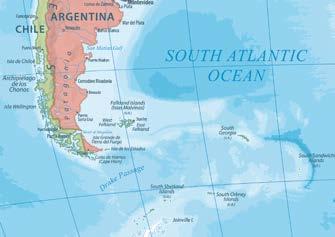
For many of us it is quite some time since we ever completed a proposal form for our household insurance. Rather we simply answer verbal questions from our broker or insurer about ourselves and the building that we want to insure and the insurer will then provide a quote based on this information. When we receive the quote and policy documentation it will be accompanied by a Statement of Fact that summarises the information that we provided and then forms an integral part of the insurance contract.
It is all too easy to overlook this document when it is sent to you but it is really important to check that the declarations that you have made are correct. Two particular statements are commonly overlooked; that an insured property is not being left unoccupied for longer than 60 consecutive days, or whatever restricted period the policy specifies; and that no building works above a specified value are in progress or planned in the next 12 months.
Unoccupied property, whether it be the principal residence or a cottage, will be subject to specific restrictions such as the water being drained or the heating being maintained at a certain temperature, but the insurer may also be interested in maintenance and security arrangements depending on the nature of the property and the value of any contents. Unfortunately, we have had incidents where we report a claim for a burst pipe or worse and it transpires that the insurer has been unaware that the property has been unoccupied for a long period and the claim is then denied.
Plans to extend a house or to carry out substantial renovation are also sometimes overlooked and not declared. The insurer will want to take in to account at the outset any works planned over a specified value when setting the terms for the policy and if they are considerable, a separate Contractor’s All Risks policy may need to be taken out to ensure that the liability for any damage in the course of the work does not slip between the parties involved. Again, the insurer will be within their rights to deny a claim if the declarations made in the Statement of Fact do not match reality.
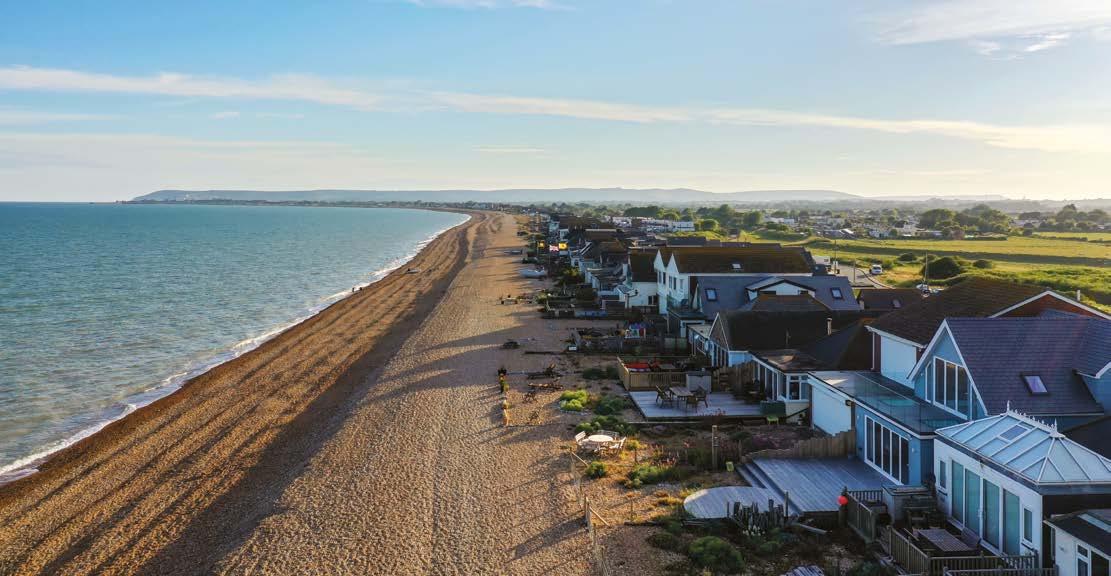
There is a duty for all of us to make sure that we disclose material facts to an insurer when seeking terms, whether it be when a policy is originally taken out or at a renewal. The Statement of Fact that accompanies the policy confirms the information that the insurer is regarding as core to the contract and it is imperative that this is checked as being correct. If it isn’t, it is essential that you tell your broker or insurer straightaway, and certainly before there is a claim, so that the policy will perform as it should.
Amongst the many challenges which horse racing faces at present it is comforting that at the very heart of the sport the allure of owning a winner is still so attractive to many.
Topics such as animal welfare, prize money, the whip and gambling have dominated column inches recently but the thrill of success on the course, particularly for a smaller owner, still gives a thrill like no other. This is perhaps why racing’s appeal has stood the test of time since its origins in the 17th century.

It is said that horse racing is the Sport of Kings and at a momentous time for the British Monarchy, Malton in North Yorkshire has its own globetrotting royal heroine providing her connections with some amazing memories. From York, to Deauville, to the Curragh, to Keeneland and back again, in 2022 Highfield Princess provided her owner John Fairley and his family with some of the biggest thrills that
horse racing has to offer, winning three Group 1 sprints in three different countries in the matter of only five weeks and pushing her prize money earnings through the £1 million barrier in the process.
And all this from only the second horse he had ever owned. Such rarefied success led to a tilt at the Breeders’ Cup Sprint at Keeneland last November where she finished a very admirable fourth. Her lucky owner, former Chairman of Highflyer Productions, which brought us Channel 4 Racing for many years, was already well versed with the challenges that taking horses across the Atlantic posed having first introduced the Breeders’ Cup to a British television audience back in the 1980s.
The fairy tale began when Fairley shrewdly bought Highfield Princess’ dam Pure Illusion as a fourteenyear-old broodmare from Sheikh Mohammed’s Godolphin operation back in 2016 for the relatively modest sum (in bloodstock terms!) of 18,000gns. She was then in foal (carrying his future star sprinter) to the freshman stallion Night Of Thunder. Taking a chance on a new stallion is not for everybody and whilst three of the dam’s previous offspring had been winners none had been able to compete in Group races. At the time of the purchase half-brother Cardsharp was just a yearling but he subsequently excelled on the track too, reaching an official rating of 111, landing seven wins and amassing over £270,000 in prize money when trained up
Highfield Princess started her 2023 campaign at York in May with a very satisfactory 2nd in the Duke of York Clipper Stakes on her seasonal reappearance. This was followed by two fantastic runs in the space of four days at Royal Ascot - 2nd in the King’s Stand (Gr1) on the Tuesday and 3rd in the Queen Elizabeth II Jubilee Stakes (Gr1) on the Saturday to show that this remarkable mare remains as good as ever. The rags to riches story shows no sign of ending!
the road in Middleham by Mark Johnston. Perhaps Pure Illusion’s astute new owner already knew something at that point?!
Anyone involved in owning or breeding horses will testify that getting them to the racecourse is never straightforward and involves many steps along the way, as well as a big slice of lady luck. The road to success was not without hiccups for Highfield Princess as she did not make her debut until the June of her three-year-old career. Whilst she ran respectably on her first three starts she began “handicapping” off a fairly lowly rating of 58. As trainer John Quinn alludes when he first started to train her “she was always a likeable filly, straightforward but backward and having pulled a few muscles early on she wasn’t up to any fast work. I advised the owner to keep her in training and that we would win a ‘nice little handicap’ with her the following year”
This is where things really took off. Not only did she win that nice little handicap, but added a further three wins in 2020, with three more the following year, including one thrillingly at Royal Ascot. 2022 then saw the step up to Group 2 and Group 1 level with wins in the Duke of York Stakes and Nunthorpe at her home course of York. Very few horses rise so rapidly up the handicap system from their opening mark – in Highfield Princess’ case a whopping 61lbs.
"I can scarcely believe what's happened," said Fairley.
"She lives just ten yards down the road in my stables. She's called Highfield Princess because we live in Highfield and John trains the horses from there. I know she won three Group 1s in five weeks, which makes it look as though we have been rushing, but John has actually been marvellously good at taking his time with the filly. He has never pushed her. One of his many talents as a trainer is that sense of timing."
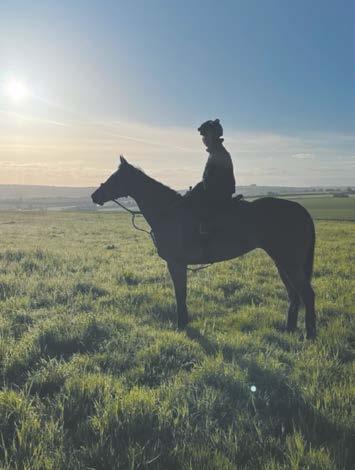
Highfield Princess scooped several awards at the end of her annus mirabliis in 2022, namely Cartier Sprinter of the Year, Yorkshire’s Horse of the Year and the Racehorse Owners’ Association’s Outstanding Sprinter of the Year. In what is likely to be her final year of racing in 2023, all options around the globe will be under consideration, and who knows, this could lead to the mare’s own end of year coronation.


TO FIND OUT MORE, WHY NOT GET IN TOUCH:
Matthew Haxby mhaxby@weatherbyshamilton.co.uk07764 153234
And what for the future once she has finished racing? Will her owner continue his quest for the next superstar when she is retired to the paddocks. “I don’t think my daughters would ever forgive me if I were to sell her!” conceded Fairley. And so the story looks set to continue beyond her racing career and provide the Fairley family with hope and excitement for years to come. There is unlikely to be any shortage of regally bred suitors for this princess.
The Fairleys and the Quinns celebrating in the Winners’ Enclosure Highfield Princess on the gallops in May 2023 John Fairley, jockey Jason Hart and groom Satrajeet Jhingree with their pride and joyIt cannot have escaped your notice that when it comes to prospects for what remains of the decade, most commentators are not exactly whipped up into a frenzy of enthusiasm.
Of course, to a degree this is warranted – economic growth has been anaemic lately, and especially in the UK, productivity seems to have risen at a slower pace since roughly 2008.
And there are plenty of headaches in the headlines too – from the US ‘debt ceiling’ debacle to the Great Real Estate Bubble of China, not to mention the ongoing conflict in Ukraine.
Yet much ink is spilled warning of worse to come, whether it’s the terminal decline of Great Britain, the sunset of American empire, or even the end of the world.
There are several reasons to discount such despondent predictions.
In the financial press, we frequently hear portents of doom emanating from market gurus who made their millions (if not billions) putting their money where their mouth is and hitting the jackpot.
Words are weighted by wealth, it seems: if a sage has hitherto proved so profitably spot-on, surely we ought to pay attention?
Not necessarily. There is no shortage of people looking to make speculative trades. Most of them fail, and we never hear of their opinions.
And perversely enough, those who have made fortunes over decades rather than overnight tend to be more circumspect about their own forecasting ability, when really it ought to be the other way around.
Ultimately, the strength of an argument does not rest on who makes it, but on its own merit. As the motto of the Royal Society goes, “Take no one’s word for it”.
Nonetheless, alarmingly bleak visions command attention. The London School of Economics has found that negative news does indeed capture more clicks. At the extreme, this manifests in cynical campaigns such as one which in 2013 lamented the imminent “End of Britain”. Ten years later, we can only suppose that collapse was postponed.
Some argue that there are evolutionary reasons for our predisposition to gloom. After all, the cost of ignoring warnings could be dearer than the benefits of attending to good cheer.

Whatever the cause, we must take care to consider the ulterior motives of those who scream that the end is near.
Visions of apocalypse go back a long way. For the most part, this is understandable – most preEnlightenment societies were trapped in vicious stagnation. The few which did make progress were short-lived, so doom-mongers stood a good chance of looking truthful.
There is a natural tendency both to make and to heed gloomy forecasts – so take them with a cellar of salt.
But the advent of rationality changed all that. With Newton’s Laws so undeniably effective in engineering progress, a culture of problem-solving and reasoned criticism was seeded.
Ever since, not even the sky has limited human ingenuity. And, unlike anything that came before, what we do with our rocketing knowledge cannot be predicted.
All we can say is that we’re collectively inclined to improve our lot in life. That which we cannot foresee – the fruit of creative endeavour – is the stuff of dreams, not nightmares.
Therefore, naively projecting past trends into the future will underestimate humanity’s unique capacity to change the rules of the game, and to our advantage.
This is why Thomas Malthus was wrong when he said, over two hundred years ago, that the world would starve. He correctly anticipated a ballooning population but failed to take into account the agricultural revolution already underway. Today, obesity is much more of a concern than famine.
This ‘bias to pessimism’ is part of the answer to Thomas Babington Macaulay’s question, “On what principle is it that with nothing but improvement behind us, we are to expect nothing but deterioration before us?”


When it comes to investments, long-term returns are relatively unaffected by modish swings in market sentiment. Instead, new wealth is created – where there was none before – by unforeseeable new ideas in the service of better living. However, such progress is not a given. Catastrophe can still strike. But one needn’t be Pangloss to dismiss prophets of woe: they prey on our fears and play down our imaginations.
Insurance policies are there to provide financial compensation in the event of an insured peril causing an unexpected loss. However, to ensure that the claims process is as smooth and efficient as possible it is crucial that the insurers are notified as soon as the damage occurs.
Failure to notify insurers about claims promptly can have a number of negative consequences. Firstly, it leads to delays in the claims process, which can be particularly frustrating for policyholders who are in urgent need of financial assistance. Secondly, it can lead to any claim payment being reduced or even being turned down altogether. Many insurance policies typically have specific time windows within which claims must be reported and failure to adhere to these can lead to complications.
Another reason for prompt notification is that it helps to ensure that all information is gathered whilst it is freshly available. In many cases, evidence such as photographs, witness statements and police reports can be crucial in determining the validity of a claim. If too much time has passed between the incident and the reporting of the claim, it can be difficult to obtain the required information, which in turn can make it much more difficult to achieve a satisfactory settlement.
Prompt notification of claims may also help to protect policyholders from potential legal disputes. In some cases, insurers may refuse to pay out a claim if they believe that the policyholder's actions contributed to the loss. However, if the policyholder notifies the insurer about the claim immediately, the better the chance of providing evidence that they were not at fault and avoiding any legal wrangle.
Insurance policies are obviously intended to protect against events in the future. This means that policyholders are expected to take reasonable steps to minimise the risk of loss or damage to their property. For example, if an owner of a house fails to take steps to prevent water damage by failing to repair a leaking roof, the insurer may refuse to pay a claim if it results in damage to the interior. Notifying insurers about it as soon as it becomes apparent, or remedying it straightaway in order to mitigate further loss avoids any difficulties of this type.
Policyholders should familiarise themselves with any specific time windows in their policies for making claims and make every effort to notify their insurer or their broker as soon as an incident occurs. Prompt action is the order of the day.
TO FIND OUT MORE, WHY NOT GET IN TOUCH:
William Johnson wjohnson@weatherbyshamilton.co.uk07966 030832

Anthony was commissioned into the Coldstream Guards in 1994 and spent the next 16 years in various Command and Staff appointments. As well as undertaking two operational tours in Northern Ireland, followed by tours in Kosovo, Iraq and Afghanistan, he also performed state ceremonial duties, which included several Queen’s Birthday Parades (‘Trooping the Colour’) and frequent Guards of Honour for visiting heads of state. He also managed to fit in some downhill skiing, competing in the Army championships over several years.
On leaving the Army in 2010, Anthony became Head of Boarding at Elstree Prep School. As well as fulfilling this key pastoral care role, he taught Latin and spent afternoons coaching rugby, football and cricket. As a permanent member of the school’s senior management team he helped to shape policies and deliver strategies.
Anthony joined Lycetts Insurance Brokers in 2015, based initially in Charlbury before moving to its Marlborough office as an Associate Director in 2019.
Anthony has lived in Gloucestershire since 2015, is married to Davina and they have two children. Away from work he is an enthusiastic sportsman, playing club cricket, tennis and golf as well as still being a keen skier. He also enjoys long family walks with his black Labrador, Vespa.
Anthony specialises in all the insurance requirements of farm, estate and private clients and is a strong addition to our rapidly growing Swindon office.
